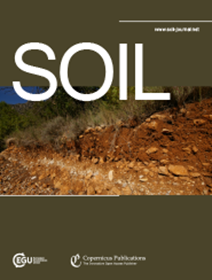Terrain is a stronger predictor of peat depth than airborne radiometrics in Norwegian landscapes
IF 4.3
2区 农林科学
Q1 SOIL SCIENCE
引用次数: 0
Abstract
Abstract. Peatlands are Earth's most carbon-dense terrestrial ecosystems and their carbon density varies with the depth of the peat layer. Accurate mapping of peat depth is crucial for carbon accounting and land management, yet existing maps lack the resolution and accuracy needed for these applications. This study evaluates whether digital soil mapping using remotely sensed data can improve existing maps of peat depth in western and southeastern Norway. Specifically, we assessed the predictive value of LiDAR-derived terrain variables and airborne radiometric data across two, >10 km2 sites. We measured peat depth by probing and ground-penetrating radar at 372 and 1878 locations at the two sites, respectively. Then we trained Random Forest models using radiometric and terrain variables, plus the national map of peat depth, to predict peat depth at 10 m resolution. The two best models achieved mean absolute errors of 60 and 56 cm, explaining one-third of the variation in peat depth. Terrain variables were better predictors than radiometric variables, with elevation and valley bottom flatness showing the strongest relationships to depth. Radiometric variables showed inconsistent predictive value – improving performance at one site while degrading it at the other. The accuracy of the national map of peat depth did not measure up to any of our remote sensing models, even though it was calibrated to the same data. Still, weak relationships with remotely sensed variables made peat depth hard to predict overall. Based on these findings, we conclude that digital soil mapping can improve existing, broad-scale maps of peat depth in Norway, but highly localized carbon stock assessments are best made from field measurements. Furthermore, the inability of models to identify peat presence outside known peatlands highlights the need for integrated mapping of peat lateral extent and depth. Together, these pathways promise more accurate landscape-scale carbon stock assessments and better-informed land management policies.地形是泥炭深度的一个更强的预测器比机载辐射测量在挪威的景观
摘要。泥炭地是地球上碳密度最高的陆地生态系统,其碳密度随泥炭层的深度而变化。泥炭深度的精确测绘对于碳核算和土地管理至关重要,然而现有的地图缺乏这些应用所需的分辨率和准确性。本研究评估了使用遥感数据的数字土壤制图是否可以改善挪威西部和东南部泥炭深度的现有地图。具体而言,我们评估了两个10平方公里站点的激光雷达衍生地形变量和航空辐射数据的预测价值。我们通过探测和探地雷达分别在两个地点的372和1878个地点测量了泥炭深度。然后,我们使用辐射和地形变量以及泥炭深度的国家地图来训练随机森林模型,以10米分辨率预测泥炭深度。两个最佳模型的平均绝对误差分别为60和56厘米,可以解释泥炭深度变化的三分之一。地形变量是比辐射变量更好的预测因子,高程和谷底平整度与深度的关系最强。辐射变量显示出不一致的预测值——在一个地点提高性能而在另一个地点降低性能。国家泥炭深度地图的精度达不到我们的任何遥感模型,即使它是根据相同的数据校准的。尽管如此,与遥感变量的弱关系使得泥炭深度难以总体预测。基于这些发现,我们得出结论,数字土壤制图可以改善挪威现有的大比尺泥炭深度地图,但高度本地化的碳储量评估最好来自实地测量。此外,由于模型无法识别已知泥炭地以外的泥炭,因此需要对泥炭横向范围和深度进行综合测绘。总之,这些途径有望实现更准确的景观尺度碳储量评估和更明智的土地管理政策。
本文章由计算机程序翻译,如有差异,请以英文原文为准。
求助全文
约1分钟内获得全文
求助全文
来源期刊

Soil
Agricultural and Biological Sciences-Soil Science
CiteScore
10.80
自引率
2.90%
发文量
44
审稿时长
30 weeks
期刊介绍:
SOIL is an international scientific journal dedicated to the publication and discussion of high-quality research in the field of soil system sciences.
SOIL is at the interface between the atmosphere, lithosphere, hydrosphere, and biosphere. SOIL publishes scientific research that contributes to understanding the soil system and its interaction with humans and the entire Earth system. The scope of the journal includes all topics that fall within the study of soil science as a discipline, with an emphasis on studies that integrate soil science with other sciences (hydrology, agronomy, socio-economics, health sciences, atmospheric sciences, etc.).
 求助内容:
求助内容: 应助结果提醒方式:
应助结果提醒方式:


